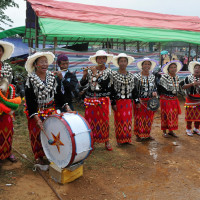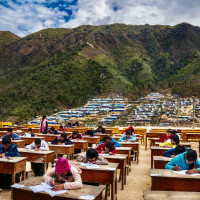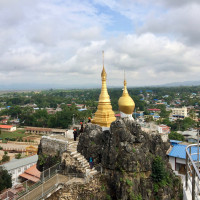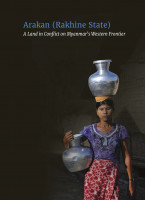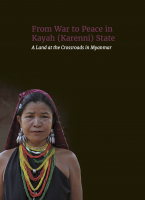The Creation of New Constituent Units in the Myanmar Context A Myanmar Commentary by Sai Wansai
Regions
The denial of ethnic rights and democratic freedoms are at the heart of the cycles of conflict and state failure in Myanmar. Currently, the ethno-political situation is delicately poised as resistance movements continue to gain ground against the SAC regime. In a fast-evolving landscape, Sai Wansai argues in this commentary that discussions need to intensify now to the challenges of constitutional change and ethno-political reform if inclusive solutions are to be found. Ethnic rights and justice are essential for future peace and stability.
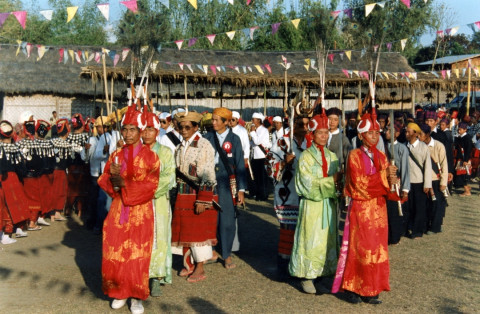
Photo credit TNI
As the struggle against military rule continues, there is no denying that the peoples of Burma/Myanmar are faced with a formidable array of challenges in trying to achieve the constitution of a federal democratic union. These include the creation of new federal ‘constituent units’ (CUs) that are demanded by a diversity of ethnic nationalities and groups. This is in addition to the issue of an ethnic ‘Bamar State’ to be drawn up on an equal basis with the seven other nationality states at present: i.e., Chin, Kachin, Karen, Kayah (Karenni), Mon, Rakhine (Arakan) and Shan.
Nowhere is the demand for the creation of new constituent administrative units presently more pronounced than in Shan State, followed by Kachin State and, to a lesser extent, Sagaing Region. Here many of the smaller nationality peoples or movements that may be termed ‘sub-groups’ in these territories are also under arms or in resistance, such as Kokang, Ta’ang and Wa. This makes the challenge of creating new federal CUs more daunting since the solutions lie in political dialogue and agreements and not through ‘zero-sum’ or ‘win-lose’ armed confrontations. Because of this, we need to explore successful solutions through a given political framework, most probably or preferably in a federal democratic union, with a set of criteria to govern the process of the creation of new CUs.
For this reason, it goes without saying that all stakeholders that are already constituent units – as well as those aspiring to become one – should sit together to write a set of rules and regulations which will reflect the desires and aspirations of local, regional and federal-level populations in a constructive way. In such a consultation, there should be no exclusions.
Before moving on to this, it is first necessary to look at how such a reform process has been conducted in a variety of countries around the world, and then briefly look at the particular issue of CU creation in the three constitutions of 1947, 1974 and 2008 drawn up or employed by successive civilian and military governments in Myanmar since independence. In addition, we need to recognise that over the decades there have been other constituent models by opposition groups, such as the 1961 Shan Federal Proposal. Most recently, these include a 2008 constitution drafted by the Federal Constitution Drafting and Coordinating Committee (FCDCC), an anti-military alliance of National League for Democracy (NLD) lawmakers and ethnic armed organisations (EAOs);1 and a 2021 Federal Democracy Charter (FDC) drafted by the National Unity Consultative Council/National Unity Government (NUCC/NUG).2 Different points of view need to be considered to cover the whole spectrum.
After this review, we need to look at the historical backdrop to the creation of constitutions and CUs, linking them to contemporary challenges facing the peoples. Finally, we need to consider why and how to go about dealing with this issue in order to benefit the whole country while resolving the decades-old conflicts that have continued since the British departure in 1948. Political solutions are integral to future peace and stability.
How other countries go about CU creation
Experience from other countries warns that great care is needed on this issue. Political controversies surrounding the creation of new CUs can be enormous, becoming a major stumbling block in the process of achieving a new federal democratic union constitution that is agreeable to all parties.
In ‘Creation of Constituent Units in Federal Systems’, George Anderson of the Center for Constitutional Transitions at NYU Law defined the challenges in June 2014: ‘Federal and devolved systems of government are based on a territorial delimitation into political states, provinces or regions (constituent units: CUs).3 As he pointed out, Myanmar is one of more than a dozen countries where the creation of new CUs is presently a critical issue, either under the aspirations of a federal constitution or in a devolved system of government.
In his study, Anderson outlined five key areas to be considered in any successful process, all of which require the agreement of a new political process and map.
- A new political map is necessary during the time of transition to federalism in order to facilitate the creation of new CUs.
- There are broadly three categories of timing when/how this new drawing can be done: during the transition to federalism; a few years after the transition; or adopting a federal constitution without resolving the political map.
- There are four variables on how the process should be conducted: centrally determined but weakly consultative; centrally determined but strongly consultative; regional decisions but subject to central rules and criteria; and/or international arbitration.
- There are two axes to consider in determining the actors and level of consensus needed in the constitutional rules for CU creation: which actors are empowered to play a role (e.g., national legislature, state legislatures, affected populations); and what levels of consent must be obtained (i.e., high, medium, low).
- Finally, variable approaches on decision-making actors should be considered: e.g., national legislature alone; national legislature plus affected CU/CUs; national legislature plus legislatures of affected CU/CUs; referendum-based procedures.
Anderson also noted that countries do not vary much with regards the approval percentage needed in endorsing a new CU. Most need at least a two-thirds majority in parliament or by public approval. Whatever the method, such a figure is adhered to by a diversity of countries around the world, including Belgium, Canada, Germany, Kenya, Nigeria, Pakistan, Spain, South Africa and Switzerland.
Finally, Anderson listed five criteria for ‘drawing a federal map or new state creation’:
- economic and physical capacity
- geographic and historic boundaries
- socio-cultural
- political geometry
- partisan considerations.
New discussions on these issues are still at early stages in Myanmar. But histories from around the world show that the challenges of CU redrawing or creation are by no means unique. All these considerations are resonant as different parties across the country presently reflect on ways that the political map might be configured in a representative union that will mean peace and justice for all.
Creation of new CUs in Myanmar’s three constitutions to date
Generally speaking, three constitutions used by successive governments after independence are referred to in Myanmar political circles: the 1947 constitution adopted after independence in 1948; the 1974 constitution introduced by the military government of the Burma Socialist Programme Party (BSPP); and the 2008 constitution drawn up under the military government of the State Peace and Development Council (SPDC). All three have sections to either create new CUs or amendment procedures promulgated under different governments.
In addition, in opposition political circles there is also a Federal Republic of Burma Constitution drafted by the FCDCC in 2008, which involved EAOs, the Democratic Alliance of Burma and National Coalition Government of the Union of Burma (NCGUB) including NLD MPs-elect. Of present discussion, there is also the Federal Democracy Charter drafted by the NUCC/NUG. The latter is not a constitution per se, and since independence the ideas for CU reform promoted by opposition movements, whether political parties or EAOs, have never been accepted by central governments. But in Myanmar’s contested landscape, such non-governmental views are essential to make the present scenario complete.
First, let us look at the three constitutions by successive governments in the light of CU creation. In general terms, all three have provisions for new CU creation.
The 1947 constitution, generally considered federal in theory but not in name, contained a number of ambiguities and anomalies in a union system, providing for just four ethnic ‘states’ – Kachin, Karen (Kawthulay), Karenni (later Kayah), Shan – and a Chin Special Division. The ethnic principles on unity, union and equality to draw up the constitution were based upon the 1947 Panglong Agreement. But to achieve acceptance on joining the new union, there were also some special agreements which saw, for example, the Karenni and Shan States allowed the right of secession after a 10-year trial period, while Kachin State did not gain this right in exchange for the inclusion of more territory.
The 1974 constitution, drawn up under military rule, provided for a centralised, one-party state under socialist ideology. In contrast to the 1947 constitution, it demarcated a quasi-symmetry on the political map for the first time: seven ethnic ‘states’: Chin, Kachin, Karen, Kayah, Mon, Rakhine and Shan; and seven ‘divisions’ in the Bamar-majority centre of the country: Irrawaddy, Magwe, Mandalay, Pegu, Rangoon, Sagaing and Tenasserim.
The 2008 constitution, whilst remaining unitary, introduced a quasi-civilian system of electoral democracy in which three ministries, select seats in parliament and special interests in government are reserved for the national armed forces (Tatmadaw/Sit-Tat). The seven ethnic ‘states’ were continued and the seven divisions renamed as ‘regions’: Ayeyarwady, Bago, Mandalay, Magway, Sagaing, Yangon and Tanintharyi. But, in new innovations, one ‘union territory’ was also demarcated (the capital Nay Pyi Taw) and five nationality ‘Self-Administered Zones’ (SAZs) – Danu, Kokang, Pa-O and Palaung (Ta’ang) in Shan State and Naga in Sagaing Region – as well as a larger Wa ‘Self-Administered Division’ (SAD) in Shan State on the basis of majority populations in two or more townships. To represent the country, there would be three levels of legislature – lower house, upper house and region/state assemblies. In another delineation, 29 electoral positions were reserved for nationalities, including the ethnic Bamar majority, as ‘Ethnic Affairs Ministers’ in states/regions where they formed a minority size (in practical terms, in excess of 50,000 people) deemed sufficient for representation.4 In essence, although not all were denoted specific territories, 20 ethnic nationalities were now marked in different ways on the political map.
From this evolution, we can see that the process of creating new CUs has been ongoing by successive governments since independence. This continued during both the tenure of the 1974 constitution under the BSPP government headed by Gen. Ne Win and the quasi-civilian 2008 constitution drawn up under the SPDC regime led by Snr-Gen. Than Shwe.
Many caveats, though, are necessary. The 1974 and 2008 constitutions were both designed to the backdrop of conflict, military rule and limitations on democratic representation and, under these systems, a 75 per cent majority has been required of parliamentary representatives to make the creation of new CUs possible. To date, such a process has never happened.
Alternative constitutions: pro-federal visions
Since independence, various alternative proposals for the creation of new CUs have been made in different forums and political circles, such as the 1948 Regional Autonomy Enquiry Commission and 1961 Shan Federal Seminar. Under military rule, they have mostly come in opposition networks, generally favouring pro-federal models, two of which have gained most recent attention and discussion.
The first is the Constitution of the Federal Republic of the Union of Burma, second draft, adopted on 12 February 2008 by the FCDCC consisting of NLD MPs-elect and EAO representatives in opposition-controlled territories in Myanmar's border areas. In terms of CU creation, the constitution set out some specific rights:
Article 53 included the right of indigenous ethnic ‘minorities’ to form an autonomous region or national area within the state or states/divisions where they reside.
Article 55 allowed the creation of ‘new states’ of the Federal Union from a continuous land area within an existing state or by the combination of continuous territories from ‘adjacent’ states or regions.
Article 49 defined the different territories to be demarcated as ‘National States’, ‘Nationalities States’ and ‘Federal Territories’ as: Arakan National State, Bama National State, Chin National State, Kachin National State, Karen National State, Karenni National State, Mon National State, Shan National State; Irrawaddy Nationalities State, Tenasserim Nationalities State (with more to be added as necessary); and the Federal Territories of the Federal Union as the Federal Capital.
In these delineations, no decisions were made as to how these CUs might be calculated. But, according to Article 56, the formation of a new state would become valid if 60 percent of the people living in the area vote in favour, a different process and lower bar than the 2008 constitution introduced in 2011 by the quasi-civilian government under President Thein Sein.
In the event, the FCDCC’s draft was largely put to one side after the NLD entered parliament in 2013 by-elections and a new EAO peace process was initiated by the Thein Sein government. Instead, attention generally focused on the potential for constitutional reform through a combination of parliamentary amendments and the 2015 Nationwide Ceasefire Agreement (NCA). Since the 2021 coup, however, the FCDDC’s 2008 draft has returned again to political discussions.
The second and more recent focus of CU debate has been the Federal Democracy Charter of the NUCC/NUG. The NUCC is a consultative body, formed prior to the NUG, including representatives of political parties, MPs-elect, EAOs and civil society groups. The FDC is not a constitution and only touches on the creation of new CUs in two paragraphs. But it has refocused attention on this key issue in the volatile context of the post-coup landscape. The FDC was declared on 31 March 2021 and ratified by the First People’s Assembly, convened on 27-29 January 2022.
The following sections occur in Part 2, Chapter 8 of the FDC, putting the creation of CUs in a federal framework:
Section 52 provides for the establishment, ‘as necessary’ of the ‘administrative, legislative and judicial mechanisms of the respective States/Federal Units’ in accordance with the ‘principle of self-determination in the context of building the federal union enshrined in the Charter’.
Section 53 ascribes the coordination of ‘legislative, administrative and judicial matters between the Union and the States/Federal Units’ to the NUCC.
In essence, the FDC acknowledges the need to create or adjust the constitutional states and regions/divisions through these discussions and in tune with the people’s aspirations, including the formation of a future ‘Bamar State’. However these processes are not mentioned directly and are, for the present, vague in their formulation.
The NUG Justice Minister’s view of redrawing the political map
In a multi-ethnic union such as Myanmar, the balanced representation of the majority Bamar population has remained a controversial challenge. This was discussed by the NUG Justice Minister U Thein Oo in a Khit Thit Media podcast in September 2022 with Bo Naga, leader of the anti-SAC Myanmar Royal Dragon Army in Sagaing Region.5 Since the SAC coup, such armed groups known as People’s Defence Forces (PDFs) have proliferated across the country, some of which are independent, some of which work with EAOs, and most are generally aligned with the NUCC/NUG.
In terms of creating a ‘Bamar State’, Thein Oo said in the interview that the accepted international norms for the creation of an ethnic state are a connected stretch of land that is unbroken. On this basis, he reasoned that the multi-ethnic territory presently designated as Tanintharyi Region could become a separate ‘state’ because Mon State stands in between. The Ayeyarwady Region, meanwhile, has a mixed population of ethnic Karen and Bamar peoples, almost half each, meaning its nationality status is shared. And Yangon Region, he said, could choose to become a separate ‘City State’ since it also has a multi-ethnic population. This, in theory, he argued would leave the remaining four regions of Bago, Mandalay, Magway and Sagaing to form a potential ‘Bamar State’ in the future.
In making these distinctions, Thein Oo pointed out that Gen. Ne Win’s creation of seven divisions (today regions) under the 1974 constitution was an unfair practice since it meant that the Bamar population received seven votes while ethnic states only held one each when determining political decisions at the national level. The same inequality, he said, was true in financial distributions since the seven regions, mostly inhabited by the Bamar population, would have more advantages than the ethnic states in funding and resources. For this reason, he believed that the creation of a ‘Bamar State’, on an equal basis to other ethnic states, would be the only appropriate way to go about building a fair federal union.
Thein Oo, however, also highlighted the difficult question as to who would be responsible for the creation of a Bamar State. If the Bamar population demarcate their own state according to their wishes, there will inevitably be problems. Likewise, other ethnic groups are not able to draw their own territorial maps as they would like on the basis of their demands. The result would be continued conflict with other claimants. For this reason, Thein Oo argued that basic agreement among stakeholder groups is a necessity to form CUs that will resolve the challenges of political representation. To do this, he said that two fundamental norms must be guaranteed: individual freedom and ethnic group rights through give-and-take in the processes of new CU formation.
For the present, these challenges of negotiation and implementation remain largely theoretical until an agreed process for peace-building and political reform can be achieved. It is not, though, too early to begin discussions, and these have already been taking place in many parts of the country since the SAC coup.
Photo credit TNI
Aspirations for new CUs and the contemporary situation on the ground
The present ethno-political structure of the country can be simplified as follows: seven ethnic states, seven regions, five self-administered zones, one self-administered division, and one union territory. Political aspirations continue to be voiced by such movements as Kayan, Lahu, Tavoyan and Zomi in different parts of the country who, since independence, have had no territorial recognition on the constitutional map. There are also identities and peoples that do not easily fit into present frameworks. Under the 2008 constitution, for example, SAZs can only be established for nationalities that form majorities in two or more townships. But there will often be populations from the same nationality living in other townships outside the SAZ where they may be considered a ‘minority’. They, too, may want political rights.
A long-standing anomaly, for example, are the Naga who live on both sides of the northern Sagaing Region and India borders. Here, to a backdrop of conflict, leaders aspire to the establishment of an independent state formed from adjoining territories in the two countries. But such a new territory would not be connected to the creation of new CUs within a federal union of Myanmar. The Naga question is thus frequently overlooked.
Also contentious is the question of the creation of a CU in north Arakan (Rakhine State) in border areas where the majority population are Muslims. This has been a source of conflict and controversy that has continued since independence in 1948, and in 1961 this claim appeared to gain short-lived life by the government’s formation of a Mayu Frontier Administration (also Mayu District), comprising Maungdaw, Buthidaung and western Rathedaung townships.6 More recently, the 2017 flight of over 750,000 Rohingya refugees into Bangladesh to escape Tatmadaw attacks, as well as the rise of the United League of Arakan/Arakan Army (ULA/AA), has made the situation even more urgent. The tri-border region with Bangladesh and India remains one of high contestation, with Chin, Rakhine and Rohingya EAOs among nationality movements looking at the challenges of constitutional reform and, in the ULA/AA’s case, future confederation.
During the past decade, however, it is in the conflict-zones in the northeast of the country where nationality groups have been most actively involved in trying to create new (or expand) CUs within the union. These are notably Pa-O, Ta’ang (Palaung) and Wa in Shan State, and Shanni (Tai-leng) in Kachin State and Sagaing Region. Adding to the ethno-political tensions, leaders of the Tatmadaw have for many years – as a ‘divide and rule’ stratagem – supported the creation of local militia (pyithusit) and, in some cases Border Guard Forces (BGFs), based upon nationality lines, including Kokang, Lisu and Rawang. All such activities have opened up the possibility for inter-ethnic conflict, and there are worries that these could erupt into open fighting in the future.
A number of challenges stand out. These are presently most acute in the north of Shan State, the country’s largest state or region, where there are three EAO alliances that need to be factored into the equations: the 2016 Northern Alliance of the Kachin Independence Organisation (KIO), (Kokang) Myanmar National Democratic Alliance Army (MNDAA), Ta'ang National Liberation Army (TNLA) and ULA-AA: the 2019 Brotherhood Alliance of the latter three EAOs; and the 2017 Federal Political Negotiation and Consultative Committee (FPNCC) which consists of the non-ceasefire KIO, MNDAA, TNLA and ULA-AA and ceasefire (Mongla) National Democratic Alliance Army (NDAA), Shan State Progress Party (SSPP) and United Wa State Army (UWSA). None of these movements signed the 2015 NCA from which several EAOs were excluded by the government and Tatmadaw from inclusion in participation.
Most recently, in a dramatic advance, the TNLA has expanded its areas of operation outside the Palaung (Ta’ang) Self-Administered Zone that was designated under the 2008 constitution. The background is complex. But following the SAC coup, the TNLA and its EAO allies ousted the rival Restoration Council of Shan State (RCSS) from northern Shan State where the latter had tried to gain ground following its 2015 signing of the NCA with the government.7 The Ta’ang population broadly welcomed the TNLA’s action, but concerns are now growing among other nationality groups that TNLA leaders are proposing the creation of an extensive Ta’ang State. This is a controversial issue that has not been publicly discussed with other parties. But, according to a TNLA map, the future state would be larger than the existing SAZ and include adjoining territories where the Ta’ang population is in a minority among other nationality groups, especially Shan (Tai).
The situation is now uncertainly poised, with the TNLA and Brotherhood Alliance forces gaining control of more townships in northern Shan State during Operation 1027 launched in October against the SAC. Already tensions have been rising due to TNLA disputes over territory with two FPNCC allies: the non-ceasefire KIO and ceasefire SSPP. Clashes were reported on 23 September and 7 November in which several soldiers on each side died. And on 29 November, the RCSS and SSPP, which had previously been in conflict, agreed an unexpected ceasefire to stop arguments over territorial ownership. Despite this truce, it is difficult to predict how conflict trends will develop during 2024.
These rivalries also draw attention to another unresolved question over territory in Shan State. This concerns the UWSA, the FPNCC’s militarily-strongest member. In terms of the ethno-political map, the UWSA effectively controls a large Wa Self-Administered Division that was demarcated under the 2008 constitution along the China borders, which party leaders have long said that they want to upgrade into a ‘Wa State’. Worries, however, remain among other nationality groups that the UWSA has aspirations to annex territories in southern Shan State along the Thailand border as well.
The potential of a further expansion was first raised after the UWSA built up a significant presence in southern Shan State following its 1989 ceasefire with the military State Law and Order Restoration Council (SLORC: later SPDC). UWSA control in these areas then gained a further boost in the late 1990s after the UWSA defeated the Mong Tai Army (MTA), led by Khun Sa who surrendered to the SLORC-SPDC, and initiated a major population transfer of over 120,000 Wa people from its territories along the China border to areas adjoining Mae Hong Son, Chiang Mai and Chiang Rai provinces in Thailand.
Subsequently, the RCSS was formed in the Thai borders by former MTA members and a revived Shan nationalist grouping under its present-day leader, Yawd Serk. But, although fighting has generally stalled, a de facto state of conflict still exists despite both the RCSS and UWSA having ceasefires with the government. And here the impasse presently stands. In an unusual designation, UWSA administration is generally referred to as two separate territories in Myanmar, ‘northern’ and ‘southern’ Wa, with the UWSA deploying an estimated 8,000 troops in five divisions in the Thai borderlands.8
Similar complexities exist in Pa-O-inhabited areas in southwest Shan State where the ceasefire Pa-O National Organisation (PNO) has dominated the Pa-O SAZ since its 2008 creation. This is an administrative status that continued after the PNO’s 2011 transition into a political party and pyithusit militia under Tatmadaw control. SAZ recognition, however, has not represented the end of Pa-O aspirations. A smaller EAO, the Pa-O National Liberation Organization, which signed the 2015 NCA with the government, and a more recent Pa-O National Federal Council have also stated aims to achieve a state-level administration or ‘Pa-O State’ that would appear to require expanded territories. In this context, rumours that Pa-O nationalists want the Shan State capital Taunggyi to be part of the future Pa-O State do not go down well among Shan and other nationality groups living in the same areas.
In Shan State, too, there are other multi-ethnic areas where there are demands for autonomy or SAZ-like delineation. In territorial terms, the most advanced is the ceasefire territory of ‘Special Region Four’ in eastern Shan State which is under the control of the National Democratic Alliance Army. With a capital at Mongla, the NDAA originates from the 1989 mutiny by non-Bamar troops from the Communist Party Burma, an event which also saw the formation of its allies, the MNDAA and UWSA. Since this time, the NDAA has administered a territory covering 4,952 square miles with a multi-ethnic population of around 100,000 people, including Akha, Lahu and Shan. Largely escaping the conflicts in other parts of Shan State, the territory is today relatively prosperous and self-sustaining through close business relations with China.
Finally, mention also needs to be made of the Shanni or Tai-leng movement in parts of Kachin State and adjoining Sagaing Region. Here the situation has become increasingly contentious after a Shanni Nationalities Army (SNA) took up arms in 2016 to demand the creation of a Shanni State. Since this time, the SNA’s political affiliations have been unclear. But working closely with the Tatmadaw, it has been widely accused of collaborating with the SAC during the past two years to the detriment of anti-regime resistance and pro-federal change. As instability continues, a local commentator warned that the future of the Shanni community ‘hangs in the balance’.9
As these examples warn, political dialogue and inclusive solutions are needed to address constitutional questions that have always been political at root. But while the representation of all peoples are demanded as the solution by nationality parties, precedent also warns that the country’s military leaders use the stratagems of ‘divide and rule’ as a means to try and advance central control. Despite the present crises, such territories as Arakan and the present-day Kayah and Shan States have traditions of self-rule and inter-ethnic tolerance. The conflicts that exist today only broke out under the post-colonial systems of government. For this reason, it is vital that strategies are found to address inter-ethnic tensions while providing sustainable solutions through common focus on union, unity and shared political dreams.
Recommendations and possible sequencing in the creation of federal CUs
Given the complexity of the post-coup fall-out, any recommendations have to be considered tentative at this stage. A large number of stakeholders must be involved in future political dialogue and change. Nevertheless it is vital to begin focusing on these challenges now if ways forward are ever to be found to address the scale of national breakdown and conflict crisis currently enveloping the country.
In this light, it is suggested that the following recommendations and sequences of action could underpin a roadmap for the creation of CUs in a future federal system of government.
- The three governmental constitutions of 1947, 1974 and 2008 are inappropriate to address the provision of new federal CUs. The first constitution is federal in theory but unitary in structure. The second is that of a socialist and totalitarian state. And the third is a quasi-civilian system of parliamentary government in which the Tatmadaw retains dominant and deciding powers.
- The FCDCC’s 2nd draft 2008 constitution presently appears the most comprehensive in approaching the creation of new CUs. But this needs to be refined and debated among stakeholder groups as well as with constitutional experts to consider the most practical ways to deliver intended outcomes.
- The anti-regime, ethno-democratic camps advocate a genuine federal union. But they need to adjust and define the constitution that they want by dialogue in political agreement together. For the moment, the non-Bamar nationalities appear to pin their hopes on the FCDCC 2nd draft 2008 constitution, while the NUCC/NUG have not made agreement further than the Federal Democracy Charter.
- NUCC/NUG representatives that are tasked with developing the federal charter are not all-inclusive enough to represent the many EAOs, political parties and civil society organisations that are not part of it. In principle, they may all have the same vision, but this is not enough. Political discussions on constitutional reform are only at a beginning – not at an end. The creation of new CUs needs to be negotiated among stakeholder groups in more detail for inclusion in a future transitional constitution.
Against this backdrop, the sequencing for the creation of new CUs could look something like the following:
- agreement of an ethnic-based federal union
- acceptance of either the need to completely redraw the whole political map or partially redraw administrative boundaries within the country as necessary
- agreement on rules and regulations on how to go about the creation of new federal CUs
- choose which actors should be empowered to play these roles (i.e., ultimately, national legislature, state legislatures, affected populations etc.) and what level of (public) consensus should be obtained (high, medium, low, referendums, elections etc.)
- decide what kind of criteria should be applied (history, economic, demographic, regional etc.)
- inclusion of rules, regulations and criteria in a transitional ‘Federal Democratic Union Constitution’ draft, with an opportunity to amend this at a later stage as necessary
- ratify the Federal Democratic Union Constitution with the processes of CU creation embodied to initiate the redrawing of the political map according to needs.
Conclusion
The constitutional crisis that has plagued Burma/Myanmar since independence from Great Britain in 1948 underpins the conflict emergency and state failure which are continuing until the present day. For this reason, we cannot afford to skirt around the core problems in creating a genuine federal democratic union if the root causes of national division are to be addressed. In other words, history has shown that the heart of the solution is democratic reform that will mean redrawing the country's political map through the redrawing or creation of CUs that cater to the aspirations of all nationalities, the ethnic Bamar population included.
As a first step, constitutional experts should consider banding together to develop rules and regulations on CU creation and political mapping in a special chapter within the constitution. Whether particular details of mapping should be resolved during the drafting of a transitional constitution or come afterwards depends on how the country’s stakeholders want to sequence these steps. That is, the provision to create federal CUs should be ingrained in the new constitution from the outset or, alternatively, their creation should only be considered after the federal constitution is in place. This is a difficult challenge, but it has to be addressed.
Equally critical, a political roadmap and process have to be agreed which will allow inclusive dialogue and political reform to take place in a stable national framework. The past fifteen years have witnessed a new constitution, general elections, a Nationwide Ceasefire Agreement and 21st-Century Panglong Conference, all of which have been effectively ended by the 2021 coup and a new cycle of conflict that has continued to escalate. In this context, there are a diversity of parties on the different sides, including the SAC, NUG, PDFs and resistance movements among nationality groups in the ethnic states, who are presently using armed struggle to advance their causes – not prioritising political dialogue in a democratic parliamentary setting. This only furthers the need to promote discussion of the creation of new CUs by political means as a fundamental element in conflict resolution and political reform.
To sum up, it is clear that the creation of new CUs is unavoidable if harmonious living under a federal democratic union is to ever be realized together. To do this, two basic notions have to be taken into account and adhered to. One is the resolution of potential conflicts, including inter-ethnic rivalry, through peaceful political dialogue and negotiation – not armed confrontation. And the second is to entrust federal-level collective leadership within a constitutional framework which reflects the aspirations of the local, regional and federal-level populations as a whole. Unlike previous constitutions, the new political system of federal democracy must be based upon a union that is built from the ground up and not imposed by a central government under a unitary structure. Through such a process, the cycles of conflict and ignoring the root causes of failure must be brought to an end.
Sai Wansai is a Shan political analyst and the ex-General Secretary of the former Shan Democratic Union.

